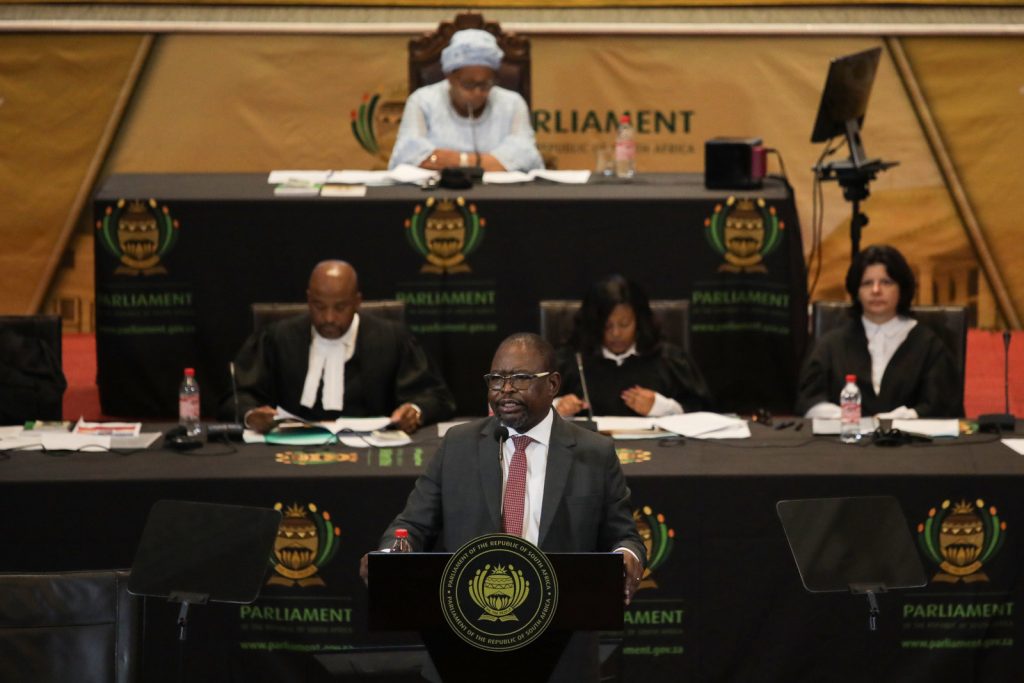

After numerous warnings of an impending fiscal crisis, Finance Minister Enoch Godongwana has doubled down on the government’s fiscal consolidation efforts.
Godongwana tabled his 2023 medium-term budget policy statement (MTBPS) on Wednesday amid warnings from left-leaning economists and civil society that spending cuts would hurt South Africa’s growth prospects and be most felt by the country’s poor.
According to the statement, the government aims to cut the main budget non-interest expenditure (total spending excluding debt service costs) by R85 billion compared with what was stated in February.
These cuts include proposed reductions of R213.3 billion, R133.6 billion of which will come from reducing department baselines and provisional allocations not assigned to votes. The other reductions are mainly from a drawdown of the 2023 budget unallocated reserves that serve as a fiscal buffer, which will be partially offset by a R2.6 billion increase in the contingency reserve in the 2025-26 financial year.
Compared with February’s 2023 budget review, the expenditure ceiling (the maximum allowable level of government spending) has decreased by R36.9 billion in 2024-25 and R47.3 billion in 2025-26.
This is as the government looks to achieve a rising primary budget surplus, where revenue exceeds non-interest expenditure, over the next three years.
During his speech on Wednesday, Godongwana noted that the MTBPS “recognises that the government must respect the budget constraint, to preserve the sustainability of government services that are being crowded out by debt service costs”.
In an effort to contain public spending ahead of what many anticipated would be a brutal MTBPS, the treasury sent letters to national and provincial departments directing them to implement a number of cost containment measures, including freezes on hiring and infrastructure projects. The treasury’s intervention raised alarm bells among left economists and civil society, who noted that the cuts would hamstring public services to the poor.
According to the MTBPS, the proposed spending revisions are designed to protect critical front line services, including health, education and policing. The treasury has also allocated R35.2 billion to extend the social relief of distress grant by another year.
While most departments will have to absorb the cost of the higher-than-budgeted public sector wage deal by reprioritising spending, including through managing headcounts, labour-intensive departments have been allocated additional funding amounting to R23.6 billion in 2023-24 to implement the agreement.
Moreover, departments will need to reprioritise and repurpose funds from existing public employment programmes to accommodate for the extension of the presidential employment initiative to 2024-25.
Earlier this year, Godongwana warned that the wage deal struck between the government and public sector workers would require significant trade-offs.
While additional funding has been provided to implement the 2023 wage deal, health, education and policing budgets look to remain constrained. Provincial education departments will have little room to hire new teachers, while the health budget will endure baseline reductions.
The MTBPS says the South African Police Service will contain costs and streamline operations as headcount declines through natural attrition.
Spending constraints come after a period of fiscal consolidation which has already inflicted a significant blow to public services.
According to a June 2023 report by Wits University’s Public Economy Project, “continuous austerity over the last decade has eroded the quality and value of public services on which the majority of South Africans rely”. The report flagged significant declines in real resource allocation to healthcare and basic education, while there have been large reductions in police headcounts over the years.
The country’s current fiscal woes have manifested as a result of a prolonged period of low economic growth as well as rising debt costs.
The MTBPS notes that since the 2023 budget, South Africa’s sovereign risk premium has risen in the wake of perceived fiscal risks. Amid higher financing costs, the state’s gross loan debt as a share of GDP is projected to stabilise at 77.7% in 2025-26, up from the 73.6% projected in the 2023 budget.
The government intends to borrow R553.7 billion a year, which will be used to finance the gap between spending and revenue collections, to refinance the redemption of maturing debt and to finance the Eskom debt relief programme.
In an effort to increase its credibility, the government is formulating new fiscal anchors which will be outlined in the 2024 budget.